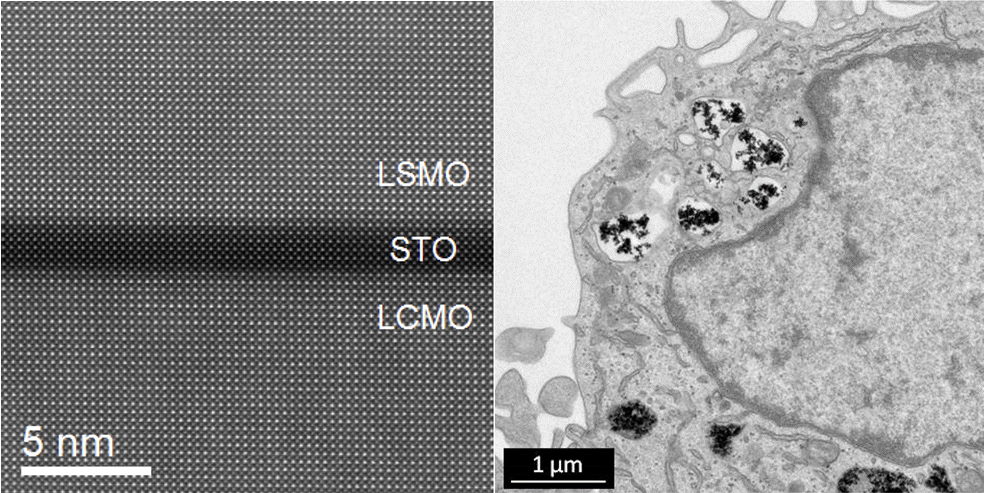MAGNA research group’s activity focuses on Nanoscience and Nanotechnology, covering researches on Spintronics, magnetic nanoparticles for life sciences and Advanced Microscopies. The main research lines of MAGNA are:
Line 1.-Nanostructured materials based on spintronic effects for energy conversion (“thermospin”) and on topological surfaces.
Subline 1.2.-New thermopiles based on spin thermoelectric effects. In 2008, the effect similar to the classical thermoelectric (based on the existence of charges) but due to the spin of the electron was discovered. In this effect, a magnetic material (if possible electrical insulator) and a Pt electrode (or another metal with strong spin-orbit coupling) are needed. Our contribution has consisted in making multilayers of (magnetite / Pt) n and we have found a notable increase in efficiency that has allowed us to develop thermopile models with power factors orders of magnitude higher than that found in other groups. Our specific objective in the proposed period will be to investigate structures in which the Pt electrode is replaced by an oxide, specifically IrO2 will be investigated and the magnetic material will grow maghemite (ferrimagnetic phase and electrical insulator). New physicochemical methods are going to be developed, alternatives to laser ablation that allow scalability and its transfer to the business sector.
Subline 1.2.-Spintronic effects on topological surfaces. 2-D materials, such as graphene, MoS2, topological insulators, and others, exhibit electronic conduction properties and spin-related effects due to the breaking of spatial symmetry on the surface, which will have a strong impact on scientific knowledge and in new logics for computing based on quantum phenomena. Our group is very well positioned in this field with recent publications in high impact journals, thanks to having unique STM microscopy infrastructures.
Line 2.-New nano-structured multiferroic materials for low consumption applications.
Subline 2.1.- New epitaxial films of multiferroic oxides. In this line, the epitaxial growth of perovskites Sr1-xBaxMnO3 (0.5≤x≤1) will be carried out on substrates that structurally resemble the phase to be formed (epitaxial engineering) favoring the appearance of ferroelectricity in magnetic materials. These investigations constitute a challenge, but their achievement would position us as a leading group worldwide.
Subline 2.2.-Multiferroic composites of new ferroelectric binary oxides. Polycrystalline and epitaxial Hf1-xZrxO (HZO) films will be grown. In particular, Ni / HZO composites will be manufactured trying to achieve, through strain, the magnetoelectric coupling between Ni (magnetostrictive) and HZO (piezoelectric). Coupling efficiency will be tested by characterizing the influence of electric fields on magnetic behaviour and its domain structure.
Line 3.- Biomedical applications of magnetic nanoparticles for applications in new oncological therapies based on magnetic hyperthermia.
Subline 3.1.-Optimization of core-shell type magnetic nanoparticles for their application in biomedicine. Core-shell nanoparticles of Fe @ C (physical methods) and Fe3O4 @ C (chemical methods) will be investigated for their evaluation and application as nano-carriers for local drug delivery.
Subline 3.2.-Development of new nanovectors based on magnetic nanoparticles encapsulated in inorganic, organic or liposomal-based coatings for stimulated drug delivery. The controlled release mechanism pursued is based on the absorption of energy from an alternating electromagnetic field (AFM) of radio frequencies by magnetic nanoparticles incorporated into the thermosensitive vector that carries the drug. The NPMs transfer heat to the thermosensitive vector, initiating drug release. Different types of encapsulations will be investigated and simulation techniques will be developed to predict both the process of energy absorption and drug release.
Subline3.3.-Oncological immunotherapy based on magnetic nanoparticles mediated by dendritic cells and / or magnetic hyperthermia. The effects of immunotherapy induced by incorporating functionalized magnetic nanoparticles with stimulating factors of the immune system in dendritic cells as well as those induced by magnetic hyperthermia using magnetoliposome-type nanovectors will be investigated.
Sublines 3.2 and 3.3 will be carried out jointly with the company Nanoscale Biomagnetics.
